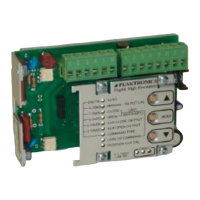16
PACS
®
logic commands. The OR command can be used to
set specific bits to "1", while the AND command can be
used to clear specific bits to "0". The EX OR (exclusive-or)
command can be used to toggle specific bits between "0"
and "1". In the following example, the OR command is
used to set bit 7, while leaving bits 0 to 6 unchanged.
PACS
®
Command (ORS#ED,#80):
6A 00 ED 80
PACS
®
TIMEOUT SETTING
00EE SING
The PACS
®
Timeout Setting parameter is a SING
byte value, where all values from $00 to $FF are valid. The
value of the parameter represents time in 0.5 second
increments. For example, a value of $14 (20 decimal)
represents 10 seconds. If a PACS
®
command is not
received before this time expires (referred to as a PACS
®
timeout), the DHC controller will clear bits 0, 1, and 2 of
the PACS
®
Control Register parameter. This has the
effect of disabling bus control of the DHC outputs.
The DHC uses a PACS
®
timeout to detect a loss of
command when it is configured for a Digital command
type. In this case, bit 0 of the Alarm Flags parameter (see
Section II) is set to "1", and the DHC outputs are controlled
according to the "loss of command setting" (see Con-
figuration parameter in Section II).
Note that the OCM-101 Modbus Option Module
supports other Modbus functions. The OCM-101 only
sends PACS
®
commands to the DHC in response to
Function Code $41 (PACS
®
Function). Broadcast
commands (node 0) with the PACS
®
Function are
processed as normal; however, the OCM-101 will not send
a responding ADU.
The PACS
®
Timeout Setting parameter can be
written at anytime as shown in the example below:
PACS
®
Command (CS#EE,20):
62 00 EE 14
The parameter can be read at anytime as shown below:
PACS
®
Command (RS#00EE):
50 00 EE
Returned Data (example):
14
PACS
®
RESET
00EF SING
The PACS
®
Reset parameter is a SING byte value
that is used to force a DHC controller reset. This has the
same effect as powering the DHC off and then on. To reset
the DHC controller via the bus, write a value of $FF to this
parameter as shown in the following example. Reading this
parameter returns an unknown value and has no significant
meaning to the user.
PACS
®
Command (CS#EF,#FF):
62 00 EF FF
USER NON-VOLATILE MEMORY
6070 DOUB
6072 DOUB
6074 DOUB
6076 DOUB
6078 DOUB
607A DOUB
607C DOUB
607E DOUB
This group of DOUB byte values provides 16 bytes
of non-volatile memory that may be used by the user for
any purpose. The initial values of these locations are
cleared to zero at the time of manufacture. Writing these
locations can only be done using the CHANGE DOUB byte
command with direct addressing (PACS
®
Code $82) as
shown in the example below. Using any other writing
command will result in no operation.
PACS
®
Command (CD#6070,#03E8):
82 60 70 03 E8
These locations can only be read using the READ
DOUB byte command with direct addressing (PACS
®
Code $51) as shown below. Any other READ command
will return $FF data.
PACS
®
Command (RD#6070):
51 60 70
Returned Data (example):
03 E8

